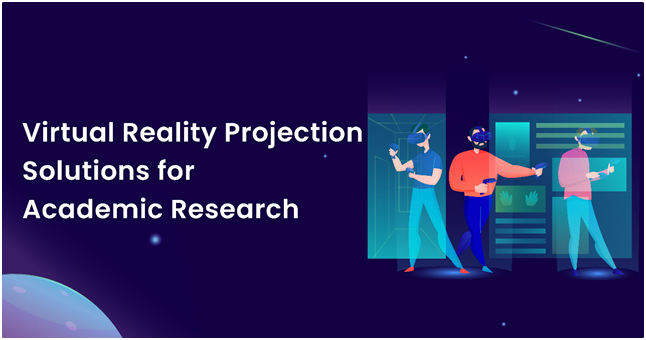Virtual Reality Projection Solutions for Academic Research
The word "virtual reality" (VR) was coined by an American physicist named Ivan Sutherland, who characterised it as a lens through which users may view the virtual world as if it were real. Since 1965 and Sutherland's paper "The Ultimate Display," this notion has come a long way. Further-more, this technology did not advance just because it provides a new viewpoint on an old prob-lem.Furthermore, the advancement of this technology is not just due to the fact that it provides a fresh viewpoint on the virtual world. On the contrary, many people find VR appealing because of the research opportunities it provides.Despite the fact that virtual reality (VR) technology has been accessible since the 1970s, it is evolving and improving and being observed as cost effective.
Architecture, education, medicine, electronic commerce, collaboration, and data visualisation are just a few of the fields where VR is being utilised to its potential. The educational system research community has a unique and useful viewpoint on VR research, and this capacity is a natural extension of previous work in various research disciplines. Multimethodological techniques that incorporate both positivist and emergent viewpoints are required.
Initial blocks in educational research
Students struggle with comprehension during the educational process owing to the complexity, importance of abstract thinking, and concepts. More and more educational institutions through-out the world are introducing strong new technology-based solutions to assist in meeting the demands of a varied student body. To initiate a better understanding in and amongst the student bodies, a thorough research based approach is required.
The library Approach to VR
In recent years, the use of VR projection for educational research has continued to expand, pro-gressing academic achievements ranging from human perception and cognition data analysis to sociology, learning and labour force training research, media and culture, engineering, design and engineering analysis, medicine, geology, and more. The introduction of VR in libraries has been a groundbreaking intervention.The purpose of these kinds of library’s is to provide access to all types of knowledge while also promoting pedagogy and research across disciplines. Academic libraries are rapidly embracing virtual reality (VR) technology for a multitude of research and teaching reasons, including improved advancements in digital collections, latest research tools, and the creation of new comprehensive educational experiences for students.
The example of Georgia State University
Georgia State University's Creative Media Sectors Institute (CMII), was accorded to project a link between creative students and the entertainment and technology industry, as a successful example. Its primary focus is on sophisticated technological workforce training, developing a national model for media entrepreneurship, and partnering with collaborators in the media and arts industries. The WorldViz CMII VR exhibit spans 3 distinct workspaces on the first floor of the Creative Media Industries Institute, including a large-area performance capture stage, a 44-foot WorldViz Projection VR system, and four collaborative backpack-based VR headset setups.This comprehensive VR strategy heralds in a new age of immersive technology for the institution and community, boosting professional development, research, and creative pursuits while positioning GSU to be a leader in the developing VR/AR/MR arena.
VR In the Field of Medical Academic Research
One of the most significant contributions of virtual reality to modern science has been in the realm of medical research. This benefit is divided into three categories. VR may be used to evaluate particular human brain capacities, or it may be used to aid in the treatment of mental and physical disorders.Finally, there are several examples of VR simulations being utilised in teaching, particularly in the realm of medical care. Education is feasible because this technology allows medical practitioners to practise certain operations without having to operate on a live patient or actual tissue.
Conclusion
Even though most people identify virtual reality with entertainment or science fiction, there are several additional applications for it. The technology offers the potential to transform many re-search procedures, and it also has real-world applications that are currently assisting individuals with their analysis-related problems. The capacity of scientists and researchers to adapt VR technology to their needs will determine how far VR can take them. With Attah you can learn more about how Virtual Reality Projection solutions play an integral part in the upcoming and already relevant research being conducted in various fields.
Contact Us
Sometimes magic is just someone spending more time on something than anyone else might reasonably expect.
Just a call away
Available: Mon-Sun 24 | 7
Atthah Info Media Pvt. Ltd.
Gurugram,
Haryana, India - 122001
+91 124 426 2229
+91 998 333 2229
For more details, just contact us at ask@atthah.com
Copyright © 2025. Atthah Info Media Pvt. Ltd. All Rights Reserved.
